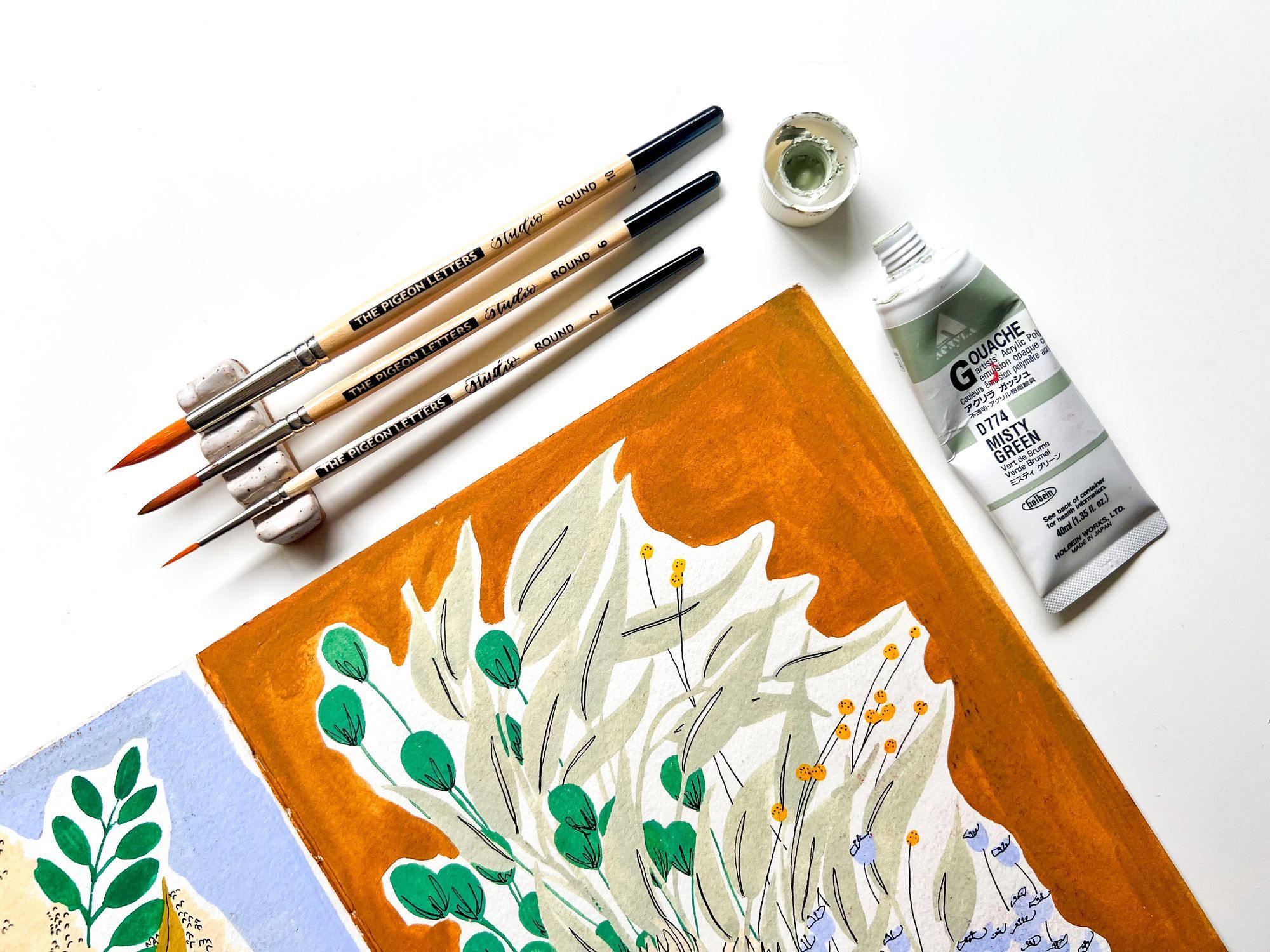I taught my first online class on modern calligraphy only about one month after I began learning how to do it myself.
It all started when I needed a new creative practice, a habit that I’ve learned is helpful for my mental health. I had seen people practicing modern calligraphy on social media and wanted to learn, so I looked for tutorials online. I struggled to find good resources, so I decided to teach myself by looking at modern calligraphy I liked and figuring out how to emulate it.
Around this time, I discovered Skillshare—an online platform offering video courses for creative skills—and saw they were running a challenge to get new teachers on the platform. I already found myself regularly oversharing how I achieved a specific technique when someone complimented my work, so teaching felt like a natural evolution. I decided to give it a shot, spent about a week planning and recording my first class, and published it on the platform.
When I got my first monthly payment for $2,200, I thought there was an extra zero on the check. The class was a hit, despite the fact that I still didn’t really consider myself “good” at calligraphy yet. I was shocked, and I was hooked.
That first class kicked off the past seven years of my career. Since then I’ve taught over 50 classes on topics from hand lettering to painting to running a creative business, written eight books sharing creative techniques, launched my own line of art materials, and grown my brand, The Pigeon Letters, into a thriving seven-figure business that supports hundreds of thousands of students.
I truly believe 80 percent of my success has been thanks to my mindset: how I see the value I have to offer, how I navigate hurdles, and how I build a business in a way that’s exciting to me and my audience. Here are four of the mindsets that have helped me build such a thriving business as a completely self-taught creator.
1. I decided I only needed to be one step ahead to provide value
It would have been so easy to hold myself back from starting my business until I considered myself a true “expert” in calligraphy. Many people feel too self-conscious about their skills to teach as a beginner, waiting months or years to gain more proficiency.
Luckily, I’m such a bulldozer that it’s pretty hard to shake my confidence. But I also truly believed that I only needed to be one step ahead of someone else to have something to teach them. In fact, I saw this “weakness” as a strength I could lean into. By teaching as I was learning, I could connect with beginners more easily and encourage them that it’s totally possible to go from zero to creating beautiful art in a short amount of time.
So, I showed up with confidence that I had something to offer students, and with full transparency about where I was. I didn’t pretend to be a master of calligraphy: I told my students that it was a new skill to me, but that I’d figured out a structure that could help other people.

Students enjoyed coming on the journey with me, and soon, being a beginner became my niche that helped me stand out among more expert creators. When students asked when I was going to teach a watercolor class, I thought, “What makes you think I know how to watercolor?!” Then, I spent a couple of months learning so I could deliver—and it’s since become a huge passion of mine and a core part of my business. When AI came on the scene and all the creatives around me were unsure about it, I dove into ways I could integrate it into my workflow and immediately turned around and taught.
It’s so empowering when you flip the switch and take ownership of whatever place you're in. And if you’re authentic about it, other people will connect with that.
2. I thoughtfully built up different revenue streams for stability
Early on, I knew that I wanted multiple revenue streams to be part of my business model so that I would feel more secure through economic ups and downs. But I also didn’t want to spread myself too thin, trying so many new things that none of them would become a solid foundation.
So, to start, I chose to hyper-focus on teaching Skillshare courses until that felt established as my core. And then, I started thinking about what other branches I wanted to add that could be rooted in the work I was already doing. One by one, I’ve built different revenue streams, giving each one about four months of my focus to see if it gains traction before deciding whether to put it aside or put more energy there.
Most of those new revenue streams came directly from listening to what my audience was asking me for and looking for ways to deliver. When students were constantly asking about what brushes, pens, and tools I used, I saw an opportunity to sell my favorites directly and even create my own line of brushes. When they asked for my teaching secrets, I launched my Creative Course Lab training and coaching program; when they wanted support on running a business, I created a membership community for creative entrepreneurs, Flock. I’ve also made money from licensing my art, selling on print-on-demand sites, hosting events and retreats, speaking and running corporate workshops, and teaching classes on other platforms.

Some of these are larger branches, some are smaller, but they all contribute to my seven-figure business. As some income streams waned over the years, I was glad to have others to lean on. And they all came about organically from the mindset of looking for opportunities in the needs of my audience, thinking about which of them excited me, and then giving them a try.
3. I rooted my marketing in excitement more than strategy
It’s wild to me how much working for yourself turns you into a full-time marketer. So many business owners let this bring them down, because marketing exhausts them or makes them feel slimy.
To avoid that feeling, I’ve always kept my marketing organic—both in the sense that I’ve never paid for ads and also in the sense that I’ve always put myself out there in ways that feel authentic to me rather than trying to keep up with the latest trends.
When I first started promoting my classes, I was shooting in the dark, impulsively sharing my excitement rather than building any kind of promotional plan. I also did a lot of cross-marketing with other artists to promote each others’ work, mostly because it sounded fun to collaborate with people I admired.
Eventually I did start to get more strategic, teaching myself about marketing best practices (and then, in true Peggy fashion, turning around and creating classes on those topics). But even then, I tried to make sure I felt enthusiastic about every promotional tactic I was implementing. For instance, when I decided to lean into growing my mailing list, I created lead magnets that provided a lot of value, like a whopping 52-page guide of my favorite supplies. Creating this offering excited me, making it easy for me to push it out to my audience.
4. I look at failure as a growth opportunity
Like every entrepreneur, I’ve gotten slapped in the face by failure. While some people get beat down and discouraged by that, it excites me because I know it means I’m being given an opportunity to learn and push myself (which, in case you couldn't tell, is one of my favorite things to do).
A great example: I’ve only had one item on my bucket list, ever, which is to write a book. About four months into teaching, I started writing a modern calligraphy how-to book and pitching it to publishers. Every single one of them said no, never responded, or said they already had something similar in the works. Instead of letting that stop me, I decided to self-publish my book—which ended up being a bestseller and landing in bookstores (which is rare for self-published books).
Nothing that I’ve achieved ever would have happened if I’d let fear of failure stop me. Yes, there’s always room to grow and improve, but that shouldn’t stop you from putting something valuable out in the world. By putting myself out there, no matter how imperfectly, I’ve helped hundreds of thousands of students tap into their creative potential—and helped myself build a thriving business that I love.
Try Buffer for free
190,000+ creators, small businesses, and marketers use Buffer to grow their audiences every month.




